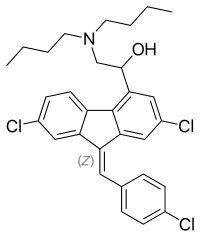ルメファントリン

 | |
| IUPAC命名法による物質名 | |
|---|---|
| |
| 臨床データ | |
| Drugs.com | 国別販売名(英語) International Drug Names |
| MedlinePlus | a609024 |
| 法的規制 |
|
| 投与経路 | Oral |
| 識別 | |
| CAS番号 | 82186-77-4 |
| ATCコード | P01BF01 (WHO) (combination with artemether) |
| PubChem | CID: 6437380 |
| DrugBank | DB06708 |
| ChemSpider | 4941944 |
| UNII | F38R0JR742 |
| KEGG | D03821 |
| ChEBI | CHEBI:156095 |
| ChEMBL | CHEMBL38827 |
| 化学的データ | |
| 化学式 | C30H32Cl3NO |
| 分子量 | 528.939 |
| |
| 物理的データ | |
| 融点 | 130 - 132 °C (266 - 270 °F) |
ルメファントリン (Lumefantrine、別名:ベンフルメトール )は抗マラリア薬の一つである。アルテメテルとの組み合わせでのみ使用される。 この組み合わせはコ・アルテメテルとも呼ばれる[1]。ルメファントリンはアルテメテルと比較して半減期が遥かに長いので、併用治療後に残存する寄生虫を除去すると考えられている[2]。
ルメファントリンは、ピロナリジンやナフトキンと共に、1967年に始まった中国の抗マラリア薬研究プロジェクト523で合成された。これらの化合物は全て、抗マラリア療法薬と組み合わせて使用される[3][4][5]。
作用機序[編集]
詳細な作用機序は不明であるが、ルメファントリン存在下ではマラリア原虫内の遊離のヘムが増加し、ヘムの重合体のへモゾインが減少することが報告されていることから、ルメファントリンはヘムの重合阻害作用を有する可能性が示唆されている[6]。アルテミシニン誘導体はヘム鉄依存的に活性化されるため、ルメファントリンは遊離のヘムを増加させることで、特に赤血球内発育の初期において、アルテミシニン誘導体と相乗的に抗マラリア作用を示している可能性がある[7]。
関連項目[編集]
参考文献[編集]
- ^ “Successful co-artemether (artemether-lumefantrine) clearance of falciparum malaria in a patient with severe cholera in Mozambique”. Travel medicine and infectious disease 1 (3): 177–9. (2003). doi:10.1016/j.tmaid.2003.09.002. PMID 17291911.
- ^ White, Nicholas J.; van Vugt, Michele; Ezzet, Farkad (1999). “Clinical Pharmacokinetics and Pharmacodynamics of Artemether-Lumefantrine”. Clinical Pharmacokinetics 37 (2): 105–125. doi:10.2165/00003088-199937020-00002. ISSN 0312-5963.
- ^ Cui, Liwang; Su, Xin-zhuan (2009). “Discovery, mechanisms of action and combination therapy of artemisinin”. Expert Review of Anti-infective Therapy 7 (8): 999–1013. doi:10.1586/eri.09.68. PMC 2778258. PMID 19803708.
- ^ http://aac.asm.org/content/56/5/2465.full
- ^ Laman, M; Moore, BR; Benjamin, JM; Yadi, G; Bona, C; Warrel, J; Kattenberg, JH; Koleala, T et al. (2014). “Artemisinin-naphthoquine versus artemether-lumefantrine for uncomplicated malaria in Papua New Guinean children: an open-label randomized trial”. PLoS Med. 11: e1001773. doi:10.1371/journal.pmed.1001773. PMC 4280121. PMID 25549086.
- ^ Combrinck JM, Mabotha TE, Ncokazi KK, Ambele MA, Taylor D, Smith PJ, Hoppe HC, Egan TJ. (2012). “Insights into the role of heme in the mechanism of action of antimalarials.”. ACS Chem Biol. 8 (1): 133-137. doi:10.1021/cb300454t. PMC 3548943. PMID 23043646.
- ^ Kümpornsin K, Loesbanluechai D, de Cozar C, Kotanan N, Chotivanich K, White NJ, Wilairat P, Gomez-Lorenzo MG, Gamo FJ, Sanz LM, Lee MCS, Chookajorn T. (2021). “Lumefantrine attenuates Plasmodium falciparum artemisinin resistance during the early ring stage.”. Int J Parasitol Drugs Drug Resist. 17: 186-190. doi:10.1016/j.ijpddr.2021.09.005.. PMC 8528645. PMID 34673330.